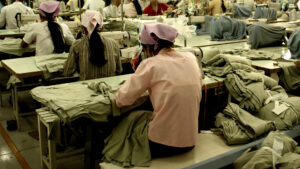By Paula M. Carbone, University of Southern California
Fast fashion is everywhere – in just about every mall, in the feeds of influencers on social media promoting overconsumption, and in ads constantly popping up online.
Its focus on the continual production of new clothing is marked by speedy fashion cycles that give it its name. Fast fashion is intended to quickly copy high-end designs, but with low-quality materials, resulting in poorly made clothing intended to be worn once or twice before being thrown away.
One of fast fashion’s leading companies, Zara, has a mission to put clothes in stores 15 days after the initial design. Another, Shein, adds up to 2,000 new items to its website daily.

While others in the fashion industry are working toward more sustainable clothing, fast fashion is focused on profit. The market’s value was estimated at about $100 billion in 2022 and growing quickly. It’s a large part of the reason global clothing production doubled from 2000 to 2014.
The big winners in this game are the corporations. The industry has a reputation for exploiting workers and for excessive pollution and extraordinary waste. Consumers are pulled into an unhealthy, spiraling pressure to buy more as cheap clothes fall apart fast.
Fast fashion also has a growing impact on the global climate. It is responsible for an estimated 8% to 10% of global greenhouse gas emissions, and its emissions are projected to grow quickly as the industry expands.
I teach courses that explore fast fashion and sustainability. The industry’s growth seems unstoppable – but a combination of legislation and willpower might just rein it in.
Understanding the harm
About 60% of fast-fashion items are made from synthetic textiles derived from plastics and chemicals that start their life as fossil fuels. When this synthetic clothing is laundered or thrown in landfills to decompose, it can release microplastics into the environment. Microplastics contain chemicals including phthalates and bisphenol A that can affect the health of humans and animals.

Natural fibers have their own impacts on the environment. Growing cotton requires large quantities of water, and pesticides can run off from farmlands into streams, rivers and bays. Water is also used in chemically treating and dyeing textiles. A 2005 United Nations-led report on cotton’s water use estimated that, on average, a single cotton T-shirt requires about 700 gallons (2,650 liters) of water from crop to clothing rack, with about 300 gallons (1,135 liters) of that water used for irrigation.
The chemicals used to process textiles for clothing for the fashion industry also contaminate wastewater with heavy metals, such as cadmium and lead, and toxic dyes. And that wastewater ends up in waterways in many countries, affecting the environment and wildlife.
Fast fashion’s high output also creates literally mountains of waste. More than 90 million tons of textile waste ends up in landfills globally each year, by one estimate, adding to greenhouse gases as it slowly decomposes. Only a small percentage of discarded clothing is recycled.
From fashionista to environmental guardian
In many cultures, people’s self-perception is intimately connected to fashion choices, reflecting culture and alliances.
The allure of buying new items comes from many sources. Influencers on social media play into FOMO – the fear of missing out. Cheap items can also lead to impulse buys.

Research shows that shopping can also create a euphoric sense of happiness. However, fast fashion’s speed and marketing can also train consumers into “psychological obsolescence,” causing them to dislike purchases they previously enjoyed, so they quickly replace them with new purchases.
Famous personalities may be helping to push back on this trend. Social media explodes when a first lady or Kate Middleton, the Duchess of York, wears an outfit more than once. The movement #30wearschallenge is starting with small steps, by urging consumers to plan to wear every piece of clothing they buy at least 30 times.
Upcycling – turning old clothing into new clothing items – and buying sustainable and high-quality clothes that can last for years is being promoted by the United Nations and other organizations, including alliances in the fashion industry.
Some influencers are also promoting more sustainable fashion brands. Research has shown that peer influence can be a powerful driver for making more sustainable choices. The largest market for fast fashion is Gen Z, ages 12 to 27, many of whom are also concerned about climate change and might reconsider their fast-fashion buys if they recognized the connections between fast fashion and environmental harm.
Some governments are also taking steps to reduce waste from fashion and other consumer products. The European Union is developing requirements for clothing to last longer and prohibiting companies from throwing out unsold textiles and footwear. France has pending legislation that, if passed, would ban publicity for fast-fashion companies and their products, require them to post the environmental impact of their products, and levy fines for violations.
Changes in consumer habits, new technologies and legislation can each help reduce demand for unsustainable fashion. The cost of cheap clothes worn a few times also adds up. Next time you buy clothing, think about the long-term value to you and the planet.![]()
Paula M. Carbone is a professor of clinical education at the University of Southern California. This article is republished from The Conversation under a Creative Commons license. Read the original article. Banner photo: A pile of inexpensive, low-quality clothes (iStock image).
Sign up for The Invading Sea newsletter by visiting here. To support The Invading Sea, click here to make a donation. If you are interested in submitting an opinion piece to The Invading Sea, email Editor Nathan Crabbe at ncrabbe@fau.edu.



